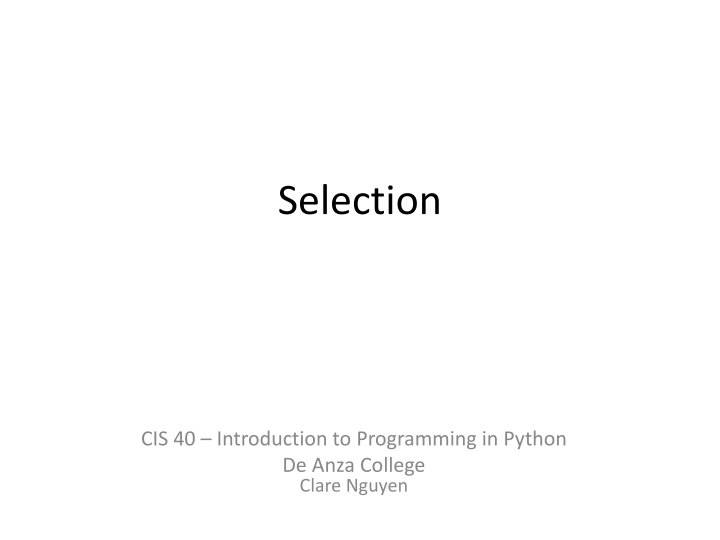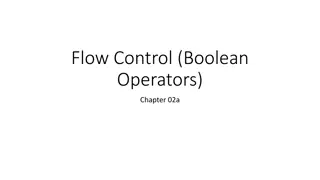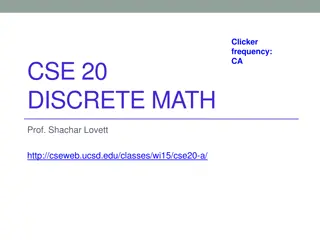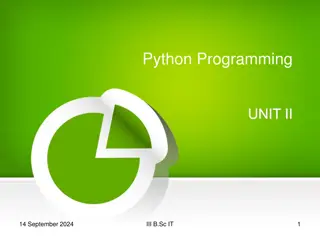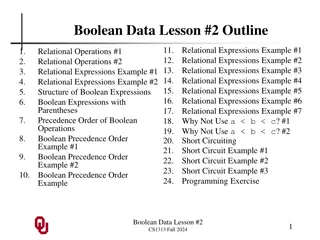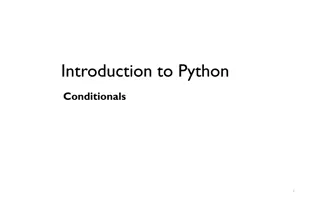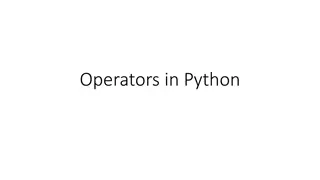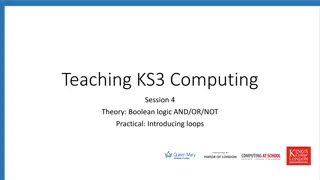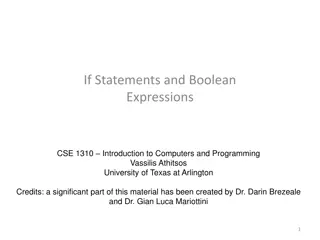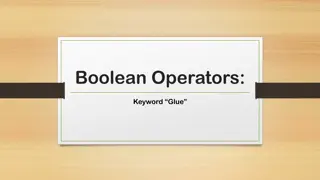Introduction to Boolean Logic and Operators in Python
Boolean logic is fundamental in programming, guiding the computer to make decisions based on conditions. Learn about Boolean expressions, relational operators, logical operators, and the order of operations in Python to create code with multiple execution paths. Understand how to evaluate expressions to True or False and use operators to compare values or combine expressions for effective decision-making in your programs.
Download Presentation

Please find below an Image/Link to download the presentation.
The content on the website is provided AS IS for your information and personal use only. It may not be sold, licensed, or shared on other websites without obtaining consent from the author.If you encounter any issues during the download, it is possible that the publisher has removed the file from their server.
You are allowed to download the files provided on this website for personal or commercial use, subject to the condition that they are used lawfully. All files are the property of their respective owners.
The content on the website is provided AS IS for your information and personal use only. It may not be sold, licensed, or shared on other websites without obtaining consent from the author.
E N D
Presentation Transcript
Selection CIS 40 Introduction to Programming in Python De Anza College Clare Nguyen
Intro So far our code has run from beginning to end by following one path of execution. Now we learn to write code that presents the computer with several execution paths, and the computer will select one path based on a condition that it evaluates. The condition can come from a user input or a calculation result, or it can come from data in a file, from a device, or from an error that s been detected. We will start with boolean logic, which is how computers make decisions, then we cover the instructions that tell the computer to make selections.
Boolean Logic When making a selection or a choice, the CPU first evaluates a an expression to True or False. Boolean expressions are expressions that result in True or False. An example of a common Boolean expression: 5 > 3 which is evaluated to True. In Python there are 2 Boolean data values: True and False and they have the bool data type. Example: evaluation of Boolean expressions True and False are data values that have bool data a type Any non-zero number is considered True. For example, the Boolean expression 42 is evaluated to True.
Relational Operators A Boolean expression uses relational operators to compare 2 values, or to see how 2 values are related to each other. Here are the list of relational operators and how they work: greater than or equal to less than or equal to equal to (note that it s 2 equal signs) not equal to Note that: = means assign or store data == means equal to
Logical Operators Logical operators are applied to Boolean expressions. There are 3 logical operators: and, or, not and is used to combine 2 Boolean expressions: num1 > num2 and num2 != 0 The entire expression is True only if both expressions (on the right and left of and) are True. or is used to combine 2 Boolean expressions: num1 > num2 or num2 != 0 The entire expression is False only if both expressions (on the right and left of or) are False. not is used to reverse the logic of a Boolean expression: not (5 > 8) is True not (10 == 10) is False
Order of Operation Adding to our existing table of order of operations: Highest ( ) parentheses ** exponentiation * / % multiply, divide, modulus + add, subtract < > <= >= inequality compare == != equality compare not logical not and logical and or logical or Lowest = assign (store data) Operators with higher precedence are evaluated first. Operators with the same precedence are evaluated left to right, except for assignments ( = ) which are evaluated right to left.
if Statement The if statement is a conditional instruction, how it runs depends on a condition. In the if statement is a contract between us and the CPU: We give the CPU: - a condition (or a Boolean expression) - 2 paths of execution The CPU: - evaluates the Boolean expression - takes only 1 of the paths of execution Example: condition Path 1 Path 2 If the condition (num2 > 0) is True, then the CPU takes Path 1 If the condition (num2 > 0) is False, then the CPU takes Path 2.
Flow Chart A flow chart is a diagram that shows the flow of execution. Example code Flow chart: read num2 print num2 True False num2 > 0? From the flow chart we can see that (num2 > 0) is a decision point. From there, 2 execution paths are possible, and the CPU will choose one path. print positive print negative print conclusion
Demo Click for a video demo of how the if statement works
Format of the if Statement (1 of 3) The if statement has the format: if Boolean_expression : True block with 1 or more statements else: False block with 1 or more statements Both True and False blocks must be indented. Both the keywords if and else must line up. Example: The True block s statements will run if the expression is True. The False block s statements will run if the expression is False. Only one of the blocks will run.
Format of the if Statement (2 of 3) When the program requirement dictates that the False block is not needed, we can have an if statement with just a True block. if Boolean_expression : True block with 1 or more statements Example requirement: only print to screen if num2 is positive. In this case we don t want to print if the condition is False, so we remove both the else and the False block. The flow chart for this if statement: True num2 > 0? If (num2 > 0) is False, then the CPU will go straight to the next statement. print positive False
Demo Click for a video demo of an if statement that only has a True block
Format of the if Statement (3 of 3) Be very careful with indentations. Python relies on proper indentation to interpret or translate our code correctly. Given these 2 blocks of code that have the same statements but different indentation, their output are different. Can you see why?
The if elif Statement When the decision is for one choice out of many choices, we use the if elif statement: if Boolean_expression_1: True block 1 elif Boolean_expression_2: True block 2 elif Boolean_expression_N: True block N else: False block Example: In the example, the user has a choice to draw one of the shapes. The last False block is for all user choices that are not one of the valid letters.
The if elif Statement When the decision is for one choice out of many choices, we use the if elif statement: if Boolean_expression_1: True block 1 elif Boolean_expression_2: True block 2 elif Boolean_expression_N: True block N else: False block Example: In the example, the user has a choice to draw one of the shapes. The last False block is for all user choices that are not one of the valid letters.
Demo Click for a video demo of the if elif statement
The Nested if Statement A True and/or False block can contain another if statement. This is called a nested if. The inner if statement is nested inside the outer if statement. if Boolean_expression1: if Boolean_expression2: Do task A else: Do task B else: Do task C Task A runs when Boolean_expression1 and Boolean_expression2 are both True. Task B runs when Boolean_expression1 is True but Boolean_expression2 is False. Task C runs when Boolean_expression1 is False. outer if inner if
Demo Click for a video demo of the nested if statement
Exception Handling (1 of 3) When the CPU is running our code and suddenly it encounters an error such that it cannot successfully complete the current instruction, it will stop running the code. This is known as an exception. Example of an exception that we ve seen earlier in the quarter: In this example, the CPU cannot successfully divide by num2, so it stops and sends out an error message. Ideally we want to catch this exception so that we can tell the computer to do something about the error, instead of print the unfriendly message above and quit on us.
Exception Handling (2 of 3) When we write code that can cause an exception: 1) we ask Python to try running the code, and 2) we write an except block of code that will be run if the exception happens. Going back to our example code: code that can cause an exception is put in a try block except block runs if an exception occurs The try except construct causes 2 paths to exist in the execution flow. If there is no exception, then the division is successful and execution skips the except block and continues. If there is exception, then the except block runs and our error message is printed. Then execution continues.
Exception Handling (3 of 3) Looking at a more complete example and the flow chart store data print status Exception try divide? print error OK Script output when num2 is 2: print result Script output when num2 is 0: Exception is handled: friendly error message and execution continues.
Whats Next In this module we learned to write code that can make choices based on conditions that occur during run time. This makes the code more adaptable and more user friendly. In the next module we learn the last construct in programming, loops, so that we can make the code even smarter.
